Extra Questions for Class 9 Science Chapter 2 Is Matter Around Us Pure
Extra questions for Class 9 Science Chapter 2 Is Matter Around Us Pure with answers is given below. Our subject expert prepared these solutions as per the latest NCERT textbook. These questions will be helpful to revise the all topics and concepts. CBSE Class 9 extra questions are the most simple and conceptual questions that are prepared by subject experts for the students to study well for the final exams. By solving these extra questions, students can be very efficient in their exam preparations.
Is Matter Around Us Pure Class 9 Science Extra Questions and Answers
Very Short Answer Questions
1: Define solvent.
Answer: The component of the solution that dissolves the other component in it is called the solvent.
2: Define solute.
Answer: The component of the solution that is dissolved in the solvent is called solute.
3: What is ‘tincture of iodine’?
Answer: A solution of iodine in alcohol is known as tincture of iodine. It has iodine (solid) as the solute and alcohol (liquid) as the solvent.
4: What are alloys?
Answer: The homogeneous mixture of two or more metals or a metal and non-metal is called an alloy. E.g., steel is an alloy of iron and carbon.
5: Give one example of gas in liquid solution.
Answer: Cold-drinks, carbon dioxide gas as solute is mixed with water as a solvent.
6: How can a solution be dilute or concentrated?
Answer: The amount of solute dissolving in a solvent decides whether the solution is dilute or concentrated.
7: What is “concentration of a solution”?
Answer: The concentration of a solution is the amount of solute present in a given amount of solution or the amount of solute dissolved in a given mass or volume of solvent.
8: State the difference between aqueous and, non-aqueous solution.
Answer: Aqueous solutions have water as solvent and non-aqueous solutions do not have water as solvent.
9: What is “solubility” of a solute?
Answer: The amount of the solute present in the saturated solution at the given temperature is called its solubility.
10: What is saturated solution?
Answer: The maximum amount of solute dissolved in a solvent at given temperature is called saturated solution, where no more solute can dissolve further.
11: What is unsaturated solution?
Answer: If the amount of solute contained in a solution is less than the saturation level, it is called an unsaturated solution.
12: How can you convert saturated solution into unsaturated or vice-versa?
Answer: Saturated solution on heating becomes unsaturated and unsaturated solution on cooling becomes saturated.
13: Why water is called universal solvent?
Answer: Water can dissolve large number of substances in it.
14: What is Tyndall effect?
Answer: The scattering of light by colloidal particles is known as Tyndall effect.
15: How can we separate colloidal mixtures?
Answer: By centrifugation, in a centrifuge machine the colloidal solution is kept in a test tube, rotated very fast and due to centrifugal force the colloidal particles are separated.
16: What is emulsion?
Answer: When both the dispersed phase and dispersing medium is liquid, it is called emulsion. E.g., milk, face cream.
17: What is aerosol?
Answer: When the solid or liquid is dispersed in a gas it is called aerosol. E.g., smoke, fog.
18: What is the principle for separation of immiscible liquids?
Answer: The principle of separating immiscible liquids into layers depending on their densities. The less denser liquid collects at the top and more denser liquid at the bottom.
19: What is chromatography?
Answer: Chromatography is the technique used for separation of those solutes that dissolve in the same solvent.
20: What is distillation?
Answer: Distillation is the separation technique of two miscible liquids that boils without decomposition and have sufficient difference in their boiling points.
21: How can you separate two liquids that have less than 25 K difference of boiling points?
Answer: To separate a mixture of two or more miscible liquids for which the difference in boiling points is less than 25 K, is fractional distillation.
22: What is condenser?
Answer: It is an apparatus used to convert gas into liquid by cooling it.
23: What is crystallisation?
Answer: When a saturated solution is heated and allowed to cool slowly, crystal of the solute dissolved in the saturated solution are separated from it. It is used to purify solids.
Short Answer Type Questions
1: Why is mixture called impure substance?
Answer: Mixture consist of different components which retain their properties and can be easily separated by physical processes, hence it is called as impure substance.
2: Give the differences between mixture and compound.
Answer:
| Mixture | Compound |
| Impure matter | Pure matter. |
| Constituents combine in faxed ratio to form a compound. | Constituents combine in fixed ratio to form a compound. |
| Constituents retain their properties. | Constituents do not retain their properties as a new substance is formed |
| Constituents can be separated by physical processes. | Constituents cannot be separated by physical processes. |
3: Distinguish between a physical change and chemical change.
Answer:
| Physical Change | Chemical Change |
| No new substance is formed. | New substance is formed. |
| It is a reversible change. | It is irreversible change. |
| The properties of constituents are retained. | The properties of constituents are not retained. |
| No new substance is formed. | Completely new substance is formed. |
4: State the properties of a solution.
Answer: Properties of a solution are:
- A solution is a homogeneous mixture.
- Particles of a solution are smaller than 1 nm and cannot be seen by naked eyes.
- Do not scatter beam of light.
- Solute particles cannot be separated from the mixture by the process of filtration and thus, solution is stable.
5: State the properties of a suspension.
Answer: Properties of a suspension
- Suspension is a heterogeneous mixture having particle size greater than 100 nm.
- The particles of a suspension can be seen by naked eyes.
- Particles can scatter a beam of light.
- It is unstable.
6: What is a colloidal solution?
Answer: It is a heterogeneous solution which appears to be homogeneous, particles size is very small and so cannot be seen with naked eyes but it is stable. E.g., milk and blood.
7: State the properties of colloidal solution.
Answer: Properties of colloidal solution.
- It is a heterogeneous mixture having particle size between 1 nm to 100 nm.
- Size of particles is very small, cannot be seen with naked eyes.
- It scatters a beam of light.
- They are stable as the particles do not settle when left undisturbed.
8: Give the applications of centrifugation.
Answer: Application of centrifugation are:
- Used in diagnostic laboratories for blood and urine test.
- Used in dairies and home to separate butter from cream.
- Used in a washing machines to squeeze out water from wet clothes.
9: Give the applications of chromatography.
Answer: Applications of chromatography are
- To separate colours in a dye.
- To separate pigments from natural colours.
- To separate drugs from blood.
10: Why is crystallisation better than evaporation?
Answer: Crystallisation is a process that separates a pure solid in the form of its crystals from a solution. Crystallisation is better than evaporation because during Evaporation some solids decompose or some, like sugar may get charred on heating to dryness. Some impurities may remain dissolved in the solution even after filtration which on evaporation contaminates the solid.
11: How will you separate a mixture of oil and water?
Answer: To separate a mixture of oil and water, we need a separating funnel as both are immiscible liquids. Pour the mixture in separating funnel and let the funnel stand undisturbed for sometime. So that separate layer of oil and water are formed. Open the stopcock of the separating funnel and pour out the lower layer of water carefully.
12: A student is given a mixture of naphthalene ball’s powder and common salt. He need to separate this mixture. How will he do this?
Answer: The properties of both naphthalene and common salt should be known, before we choose the separation technique.
Naphthalene is a sublimate which on heating changes to gaseous state directly. Hence to separate a volatile compound (sublimate) from a non-volatile compound (non-sublimate), the sublimation process is used.
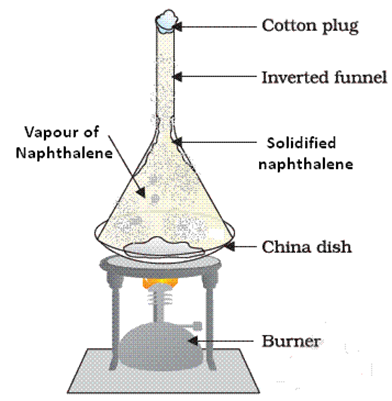
In a China dish the mixture is kept, and is placed on a stand. An inverted funnel is kept over the mixture in China dish with plugged stem. The sublimate on heating gets collected on the funnel and common salt remains in the China dish.
13: How can we obtain different gases from air?
Answer: Air is a homogeneous mixture and its components can be separated by fractional distillation.
14: Draw a flow diagram to show the water purification system in water works.
Answer:

Water is collected in the reservoir → The water is sent to sedimentation tank to allow solids to settle → It is then passed to 2nd tank i.e., loading tank, so that the suspended impurities are loaded to settle down as sediment. → Then water reaches the filtration tank
In filtration tank water passes through different layers of sand and gravel as shown in the above figure this is for adsorption of impurities.
The clear water reaches a chlorinated tank where water is mixed with bleaching powder/chlorine to kill bacteria and then supplied to houses.
15: Why is air considered as a mixture and not compound?
Answer: Air is considered as a mixture because it exhibits following properties:
1. Each component present in air retains its properties.
2. Each component can be separated by simple physical processes.
3. The components do not have any fixed proportion. All gases are present in different amount. Example, in greener area—more oxygen and water vapour is present; near industrial area—air consists of lot of impurities and smoke suspended in it.
16: How can you prove that water is a compound?
Answer: Water is a compound because if we pass electricity through it then at two different electrodes, we get two different gases i.e., oxygen and hydrogen during electrolysis of water. The ratio of oxygen: hydrogen is 1 : 2 by number of molecules.
1. The properties of oxygen and hydrogen gases sire entirely different from that of liquid water.
2. The ratio of oxygen: hydrogen combination is always constant i.e., 1: 2 by volume.
3. To separate the components of water, we need electrolytic cell, and it is not a simple process.
17: How can we convert saturated solution into unsaturated by heating?
Answer: Saturated solution is said to be saturated at a given temperature when there is no more scope of solute particles to dissolve /dissociate into water. It is because the solute particle has taken all the inter molecular space present in the solvent.
On heating, the molecules of solvent gain kinetic energy, start vibrating and try to move away from each other thereby accommodating some more solute particle in this space and hence it becomes an unsaturated solution.
18: What is the difference in fog and smoke?
Answer: Fog is a colloidal solution with liquid dispersed in gas.
Smoke is a colloidal solution with solid dispersed in gas.
19: If 20g of salt is present is 220 g of solution, calculate the concentration of solution:

Long Answer Type Questions
1. Fractional distillation is suitable for separation of miscible liquids with a boiling point difference of about 25 K or less. What part of fractional distillation apparatus makes it efficient and possess an advantage over a simple distillation process. Explain using a diagram.
Answer:
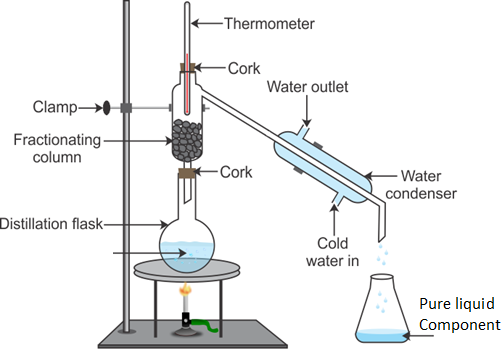
Apparatus used for fractional distillation has a fractionating column. A simple fractionating column has glass beads in it which provide additional surface area because of which the vapours can spread and cool rapidly. Hence, fractionating column is used to provide the additional surface and to facilitate the cooling of vapour in many cycles.
2. (a) Under which category of mixtures will you classify alloys and why?
Answer: When constituent particles of a combination of two or more element or compound retains their properties, then it is called mixture. In an alloy the constituent particles, hence alloys are classified as mixture. For example; steel is an alloy of carbon and iron.
(b) A solution is always a liquid. Comment.
Answer: Since, a solution is the homogeneous mixture of two or more substances, thus it is not necessary that a solution would always a liquid. A solution can be in all the three states of matter. A solution is a homogeneous mixture and can be in all the three states of matter.
Example:
(i) Solution of alcohol in water is a liquid.
(ii) Air is a solution of different gas.
(iii) Alloy is a solution which is in the form of solid.
(c) Can a solution be heterogeneous?
Answer: Solution is defined as the homogeneous mixture, hence a solution cannot be heterogeneous. But when a mixture becomes heterogeneous, it cannot be fall under the definition of solution.
3. A child wanted to separate the mixture of dyes constituting a sample of in36. A child wanted to separate the mixture of dyes constituting a sample of ink. He marked a line by the ink on the filter paper and placed the filter paper in a glass containing water as shown in Fig. The filter paper was removed when the water moved near the top of the filter paper.
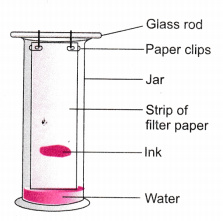
(i) What would you expect to see, if the ink contains three different coloured components?
Answer: Streaks of different colours can be seen on the filter paper.
(ii) Name the technique used by the child.
Answer: Chromatography
(iii) Suggest one more application of this technique.
Answer: Chromatography is used for separating pigments from colours, for the separation drugs from blood sample, etc.
4. A group of students took an old shoe box and covered it with a black paper from all sides. They fixed a source of light (a torch) at one end of the box by making a hole in it and made another hole on the other side to view the lig37. A group of students took an old shoe box and covered it with a black paper from all sides. They fixed a source of light (a torch) at one end of the box by making a hole in it and made another hole on the other side to view the light. They placed a milk sample contained in a beaker/tumbler in the box as shown in the Fig. They were amazed to see that milk taken in the tumbler was Fig. illuminated. They tried the same activity by taking a salt solution but found that light simply passed through it?
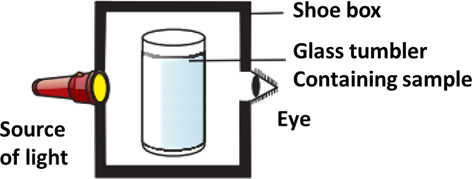
(a) Explain why the milk sample was illuminated. Name the phenomenon involved.
Answer: Since, milk is a colloid and when light scattered from the particles of colloids, it is illuminated, thus light was illuminated when passed through the milk. This is known as Tyndall Effect.
(b) Same results were not observed with a salt solution. Explain.
Answer: For scattering of light the size of particles should be large enough. Since the particles of solution are not enough to scattered the beam of light, hence same result were not observed.
(c) Can you suggest two more solutions which would show the same effect as shown by the milk solution?
Answer: Soap bubbles and fog are the colloids, hence same effect, i.e. scattering of light is shown by these. This is known as Tyndall effect.
5. Classify each of the following, as a physical or a chemical change. Give reasons.
(a) Drying of a shirt in the sun.
Answer: Drying of shirt in the sun is a Physical change. Since in this change no new substance is formed.
(b) Rising of hot air over a radiator.
Answer: Since, in rising of hot air over a radiator no new substance is formed, hence it is a Physical change.
(c) Burning of kerosene in a lantern.
Answer: While burning of kerosene in a lantern carbon dioxide, and water vapour is formed, hence it is a Chemical change.
(d) Change in the colour of black tea on adding lemon juice to it.
Answer: In this change a new substance is formed, hence it is a Chemical change.
(e) Churning of milk cream to get butter.
Answer: While churning of milk cream to get butter, no new substance is formed, hence it is a Physical change.
6. During an experiment the students were asked to prepare a 10% (Mass/Mass) solution of sugar in water. Ramesh dissolved 10g of sugar in 100g of water while Sarika prepared it by dissolving 10g of sugar in water to make 100g of the solution.
(a) Are the two solutions of the same concentration
Answer: No, the two solutions have different concentrations.
(b) Compare the mass % of the two solutions.
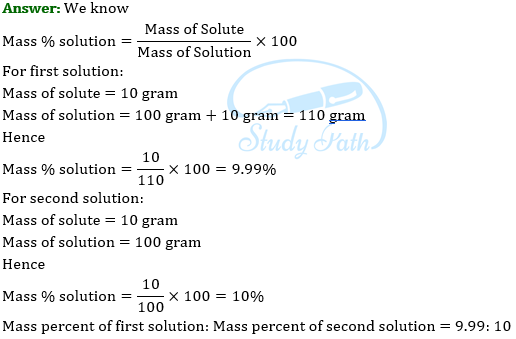
7. You are provided with a mixture containing sand, iron filings, ammonium chloride and sodium chloride. Describe the procedures you would use to separate these constituents from the mixture?
Answer: The given mixture can be separated using the following process.
Magnetic Separation: Using magnetic separation the iron fillings can be separated from the given mixture. In this a magnet is hover just above the mixture, since iron is a magnetic substance it is attracted by magnet and stuck with it. By this first of all iron fillings are separated.
Sublimation: After the separation of iron fillings, ammonium chloride is separated by the process of sublimation.
Since, ammonium chloride is a sublimate and it turns into vapour directly without changing into liquid, thus when the mixture is sublimated, the ammonium chloride is deposited over the inner wall of funnel leaving the sodium chloride and sand in the watch glass. Ammonium chloride is separated by scratching from the inner wall of the funnel.
Filtration: Now the left mixture of sand and sodium chloride is put in water, after stirring the sodium chloride is dissolved in water. The solution is separated by the process of filtration. The sand left over the filter paper is separated out.
Vapourisation: By the process vaporization, the liquid so obtained is vapouried and crystals of ammonium chloride can be obtained.
Hence, by using the methods of magnetic separation, sublimation, filteration and vapourisation and crystallization the component of given mixture of sand, iron fillings, ammonium chloride and sodium chloride can be separated.
8. Calculate the mass of sodium sulphate required to prepare its 20% (mass percent) solution in 100g of water?

9: Give the difference between true solution, colloidal solution and suspension.
Answer: The difference between true solution, colloidal solution and suspension
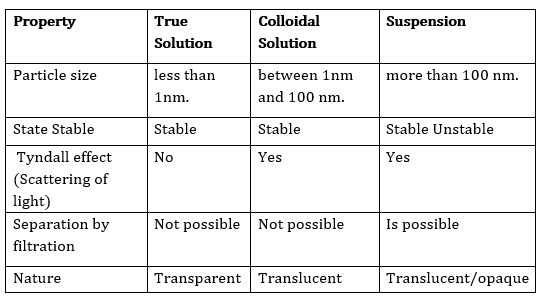
10: State the different types of colloids with examples.
Answer:
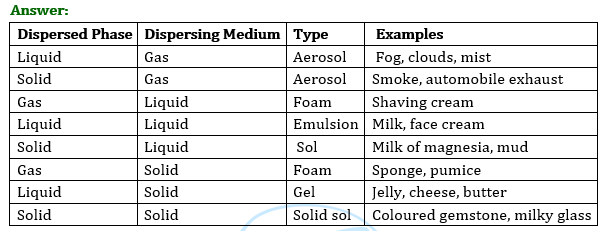
11: (a) Define solution.
(b) Give different types of solutions with one example each.
Answer: (a) Solution: It is a homogeneous mixture of two or more substances. It consists of solute and solvent.
(b) Different types of solution:
(i) Based on solvent—Aqueous and non-aqueous Aqueous solution has water as solvent (sugar + water) Non-aqueous solution has some other solvent but not water. Example, (sulphur + carbon disulphide)
(ii) Depending on the amount of solute dissolved in solvent—Dilute solution and concentrated solution
Dilute solution—Less amount of solute particles are present in a solvent.
Concentrated solution—Amount of solute present in its maximum capacity in a solvent.
(iii) Amount of solute present in its maximum capacity at a given temperature—Saturated and unsaturated solution.
Saturated solution—It is a solution in which no more solute can further dissolve in a given solvent at a given temperature.
Unsaturated solution—It is a solution in which some more solute can dissolve in a solvent at a given temperature.
(iv) Depending on the size of solute particles
True solution Size is very small and particles cannot be seen through naked eyes
Suspension Size is very big and can be seen through naked eyes
Colloid Size is intermediate between true solution and suspension
12: How can you separate the following mixtures?
(a) Sand + iron
(b)Cream from milk
(c) Salt + water
(d) Ammonium chloride + NaCl
(e) Copper sulphate + water
(f) Rice and dal (uncooked)
(g) Gases from air
(h) Petrol and diesel from crude oil
(i) Drugs from blood
(j) Acetone from water
Answer:
| Sand + iron | magnetic separation |
| Cream from milk | centrifugation |
| Salt + water | evaporation |
| Ammonium chloride + NaCl | sublimation |
| Copper sulphate + water | crystallisation |
| Rice and dal (uncooked) | hand picking |
| Gases from air | fractional distillation |
| Petrol and diesel from crude oil | fractional distillation |
| Drugs from blood | chromatography |
| Acetone from water | distillation |
Value Based Questions
1: Anil’s sister accidentally added some water into the bottle containing olive oil and she was afraid of the scolding. Anil helped his sister and separated the water from olive oil using bottle as separating funnel.
(a) What is the principle of using and working of separating funnel?
(b) Suggest two separation techniques used to separate liquid mixtures.
(c) What value of Anil is seen in the above case?
Answer: (a) The principle of separating funnel is difference in the densities of two liquids.
(b) Liquid mixtures can be separated by distillation and fractional distillation.
(c) Anil showed the value of helping, caring and responsible behaviour.
2: Preeti saw a labour entering into the sewage manhole immediately after removing the lid. She promptly stopped the labour from entering into the manhole and told him to wait for some time before he enters into it.
(a) What will happen if the labour immediately enters into the manhole for cleaning) after removing the lid?
(b) Name main gases that are released from the manhole.
(c) What value of Preeti is seen in the above act?
Answer: (a) If the labour immediately enters the manhole on removing its lid he would die due to suffocation and inhalation of poisonous gases which are compressed and released by sewage.
(b) Gases released from the sewage manhole are methane, carbon dioxide and hydrogen sulphide.
(c) Preeti shows the value of moral responsible behaviour and aware citizen.
3: Prasanna wanted to buy a deodorant from the shop. While buying a bottle he felt that it was slightly heavier than usual deodorant bottle that he purchased everytime. He read the weight mentioned on the bottle and told the shopkeeper to weigh the same. He found the bottle was heavy and on opening the deodorant bottle he found it half-filled with water. He complained the matter to the consumer authority.
(a) Define density.
(b) Apart from water what is the other substance that some shopkeepers add into the deodorant.
(c) What value of Prasanna is reflected in this act?
Answer: (a) Density of any substance is defined to be the mass of the substance per unit volume.
(b) One can add some cheap gases or compressed air in the deodorant bottles.
(c) Prasanna showed the value of being having leadership quality, rightful, aware and responsible citizen.
4: Rita’s father always got his vehicle checked for pollution control. He got it tested for the aerosol if released by his car. He also uses unleaded petrol and makes use of public transport wherever possible. He sparingly use his car.
(a) What is aerosol?
(b) What happens when smoke released from vehicle mixes with fog?
(c) What are the values of Rita’s father is reflected here?
Answer: (a) When the solid or liquid is dispersed in a gas it is called aerosol e.g. smoke.
(b) When smoke mixes with fog it forms smog.
(c) Rita’s father is an aware citizen, environmentally concerned and dutiful.